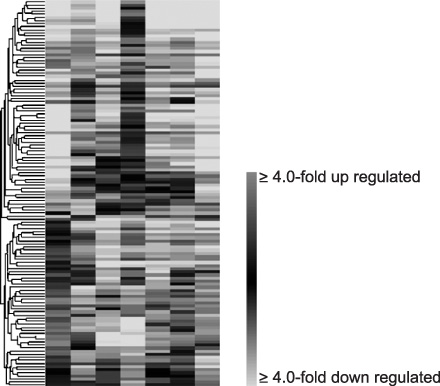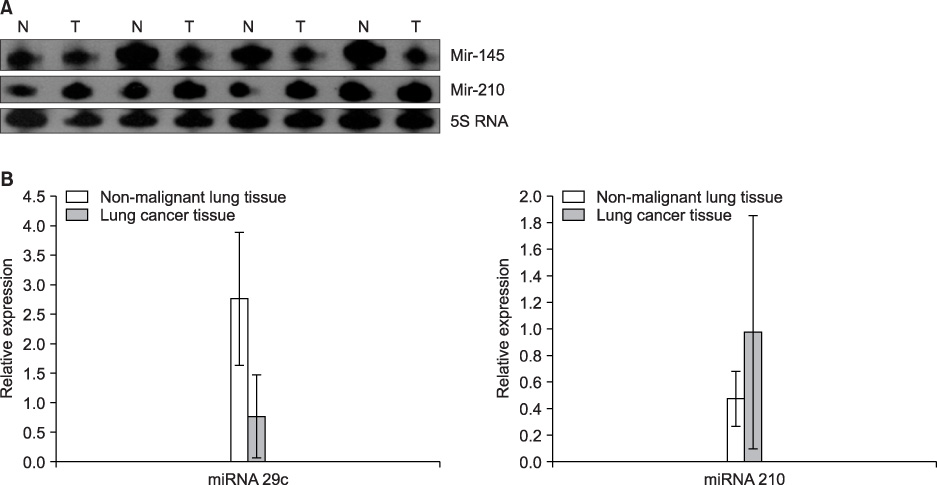Tuberc Respir Dis.
2009 Nov;67(5):413-421.
MicroRNA Expression Profiles in Korean Non-Small Cell Lung Cancer
- Affiliations
-
- 1Department of Internal Medicine, Konyang University Hospital, Daejeon, Korea.
- 2Department of Thoracic Surgery, Konyang University Hospital, Daejeon, Korea.
- 3Myunggok Research Institute for Medical Science, Konyang University, Daejeon, Korea.
- 4Department of Biochemistry, Kyungpook National University School of Medicine, Daegu, Korea. jaeyong@knu.ac.kr
- 5Department of Hospital Pathology, Daejeon St. Mary's Hospital, Daejeon, Korea.
- 6Department of Internal Medicine, Kyungpook National University Hospital, Daegu, Korea.
Abstract
- BACKGROUND
MicroRNAs (miRNAs) play an important role in the regulation of cell proliferation, apoptosis, development and differentiation. Several studies have shown that aberrant expression of miRNAs is involved in cancer development and progression by regulating the expression of proto-oncogenes or tumor suppressor genes. In this study, we investigated miRNA expression profiles in Korean patients with non-small cell lung cancer (NSCLC).
METHODS
We performed miRNA microarray analysis containing 60~65 bp oligonucleotide probes representing human 318 miRNAs and validated the results of the microarray with Northern blot analysis or quantitative RT-PCR. Next, we examined the correlation between miRNA expression and the target gene transcriptional profile using a human whole-genome-expression microarray.
RESULTS
We showed that 35 miRNAs were expressed differentially in the NSCLCs and corresponding non-malignant lung tissues. We showed that 35 miRNAs were expressed differentially in the NSCLCs and corresponding non-malignant lung tissues. Thirteen of the 35 differentially expressed miRNAs were newly identified in the present study. Of the 35 miRNAs, 2 (miR-371 and miR-210) were over-expressed in lung cancers, and 33 miRNAs, including miR-145, were under-expressed in lung cancers. miR-99b expression consistently showed a negative correlation with FGFR3 expression.
CONCLUSION
Albeit a small number of patients were examined, these results suggest that miRNA expression profiles in Korean lung cancers may be somewhat different from the expression profiles reported on lung cancers in Western populations. The findings suggest that miR-99b might be a tumor suppressor through its up-regulation of FGFR3.
Keyword
MeSH Terms
Figure
Reference
-
1. Ambros V. The functions of animal microRNAs. Nature. 2004. 431:350–355.2. Bartel DP. MicroRNAs: genomics, biogenesis, mechanism, and function. Cell. 2004. 116:281–297.3. Lim LP, Lau NC, Garrett-Engele P, Grimson A, Schelter JM, Castle J, et al. Microarray analysis shows that some microRNAs downregulate large numbers of target mRNAs. Nature. 2005. 433:769–773.4. Bentwich I, Avniel A, Karov Y, Aharonov R, Gilad S, Barad O, et al. Identification of hundreds of conserved and nonconserved human microRNAs. Nat Genet. 2005. 37:766–770.5. Berezikov E, Guryev V, van de Belt J, Wienholds E, Plasterk RH, Cuppen E. Phylogenetic shadowing and computational identification of human microRNA genes. Cell. 2005. 120:21–24.6. Cheng AM, Byrom MW, Shelton J, Ford LP. Antisense inhibition of human miRNAs and indications for an involvement of miRNA in cell growth and apoptosis. Nucleic Acids Res. 2005. 33:1290–1297.7. Xu P, Guo M, Hay BA. MicroRNAs and the regulation of cell death. Trends Genet. 2004. 20:617–624.8. Karp X, Ambros V. Developmental biology. Encountering microRNAs in cell fate signaling. Science. 2005. 310:1288–1289.9. Chen CZ, Li L, Lodish HF, Bartel DP. MicroRNAs modulate hematopoietic lineage differentiation. Science. 2004. 303:83–86.10. Calin GA, Sevignani C, Dumitru CD, Hyslop T, Noch E, Yendamuri S, et al. Human microRNA genes are frequently located at fragile sites and genomic regions involved in cancers. Proc Natl Acad Sci U S A. 2004. 101:2999–3004.11. Zhang L, Huang J, Yang N, Greshock J, Megraw MS, Giannakakis A, et al. microRNAs exhibit high frequency genomic alterations in human cancer. Proc Natl Acad Sci U S A. 2006. 103:9136–9141.12. Esquela-Kerscher A, Slack FJ. Oncomirs - microRNAs with a role in cancer. Nat Rev Cancer. 2006. 6:259–269.13. Calin GA, Croce CM. MicroRNA signatures in human cancers. Nat Rev Cancer. 2006. 6:857–866.14. Gartel AL, Kandel ES. miRNAs: little known mediators of oncogenesis. Semin Cancer Biol. 2008. 18:103–110.15. Calin GA, Dumitru CD, Shimizu M, Bichi R, Zupo S, Noch E, et al. Frequent deletions and down-regulation of micro-RNA genes miR15 and miR16 at 13q14 in chronic lymphocytic leukemia. Proc Natl Acad Sci U S A. 2002. 99:15524–15529.16. Takamizawa J, Konishi H, Yanagisawa K, Tomida S, Osada H, Endoh H, et al. Reduced expression of the let-7 microRNAs in human lung cancers in association with shortened postoperative survival. Cancer Res. 2004. 64:3753–3756.17. Johnson SM, Grosshans H, Shingara J, Byrom M, Jarvis R, Cheng A, et al. RAS is regulated by the let-7 microRNA family. Cell. 2005. 120:635–647.18. He L, Thomson JM, Hemann MT, Hernando-Monge E, Mu D, Goodson S, et al. A microRNA polycistron as a potential human oncogene. Nature. 2005. 435:828–833.19. Hayashita Y, Osada H, Tatematsu Y, Yamada H, Yanagisawa K, Tomida S, et al. A polycistronic microRNA cluster, miR-17-92, is overexpressed in human lung cancers and enhances cell proliferation. Cancer Res. 2005. 65:9628–9632.20. Michael MZ, SM OC, van Holst Pellekaan NG, Young GP, James RJ. Reduced accumulation of specific microRNAs in colorectal neoplasia. Mol Cancer Res. 2003. 1:882–891.21. Lu J, Getz G, Miska EA, Alvarez-Saavedra E, Lamb J, Peck D, et al. MicroRNA expression profiles classify human cancers. Nature. 2005. 435:834–838.22. Yanaihara N, Caplen N, Bowman E, Seike M, Kumamoto K, Yi M, et al. Unique microRNA molecular profiles in lung cancer diagnosis and prognosis. Cancer Cell. 2006. 9:189–198.23. Yu SL, Chen HY, Chang GC, Chen CY, Chen HW, Singh S, et al. MicroRNA signature predicts survival and relapse in lung cancer. Cancer Cell. 2008. 13:48–57.24. Porkka KP, Pfeiffer MJ, Waltering KK, Vessella RL, Tammela TL, Visakorpi T. MicroRNA expression profiling in prostate cancer. Cancer Res. 2007. 67:6130–6135.25. Iorio MV, Visone R, Di Leva G, Donati V, Petrocca F, Casalini P, et al. MicroRNA signatures in human ovarian cancer. Cancer Res. 2007. 67:8699–8707.26. Volinia S, Calin GA, Liu CG, Ambs S, Cimmino A, Petrocca F, et al. A microRNA expression signature of human solid tumors defines cancer gene targets. Proc Natl Acad Sci U S A. 2006. 103:2257–2261.27. Du YX, Cha Q, Chen XW, Chen YZ, Huang LF, Feng ZZ, et al. An epidemiological study of risk factors for lung cancer in Guangzhou, China. Lung Cancer. 1996. 14:Suppl 1. S9–S37.28. Lee C, Kang KH, Koh Y, Chang J, Chung HS, Park SK, et al. Characteristics of lung cancer in Korea, 1997. Lung Cancer. 2000. 30:15–22.29. Gazdar AF, Shigematsu H, Herz J, Minna JD. Mutations and addiction to EGFR: the Achilles 'heal' of lung cancers? Trends Mol Med. 2004. 10:481–486.30. Marchetti A, Martella C, Felicioni L, Barassi F, Salvatore S, Chella A, et al. EGFR mutations in non-small-cell lung cancer: analysis of a large series of cases and development of a rapid and sensitive method for diagnostic screening with potential implications on pharmacologic treatment. J Clin Oncol. 2005. 23:857–865.31. John B, Enright AJ, Aravin A, Tuschl T, Sander C, Marks DS. Human MicroRNA targets. PLoS Biol. 2004. 2:e363.32. Lewis BP, Shih IH, Jones-Rhoades MW, Bartel DP, Burge CB. Prediction of mammalian microRNA targets. Cell. 2003. 115:787–798.33. Krek A, Grun D, Poy MN, Wolf R, Rosenberg L, Epstein EJ, et al. Combinatorial microRNA target predictions. Nat Genet. 2005. 37:495–500.34. Lee Y, Jeon K, Lee JT, Kim S, Kim VN. MicroRNA maturation: stepwise processing and subcellular localization. EMBO J. 2002. 21:4663–4670.35. Wang T, Zhang X, Obijuru L, Laser J, Aris V, Lee P, et al. A micro-RNA signature associated with race, tumor size, and target gene activity in human uterine leiomyomas. Genes Chromosomes Cancer. 2007. 46:336–347.36. Bernard-Pierrot I, Brams A, Dunois-Larde C, Caillault A, Diez de Medina SG, Cappellen D, et al. Oncogenic properties of the mutated forms of fibroblast growth factor receptor 3b. Carcinogenesis. 2006. 27:740–747.37. Kang S, Dong S, Gu TL, Guo A, Cohen MS, Lonial S, et al. FGFR3 activates RSK2 to mediate hematopoietic transformation through tyrosine phosphorylation of RSK2 and activation of the MEK/ERK pathway. Cancer Cell. 2007. 12:201–214.38. Marek L, Ware KE, Fritzsche A, Hercule P, Helton WR, Smith JE, et al. Fibroblast growth factor (FGF) and FGF receptor-mediated autocrine signaling in non-small-cell lung cancer cells. Mol Pharmacol. 2009. 75:196–207.
- Full Text Links
- Actions
-
Cited
- CITED
-
- Close
- Share
- Similar articles
-
- The Long Noncoding RNA DUXAP8 Facilitates the Malignant Progression of Colon Cancer via the microRNA-378a-3p/FOXQ1 Axis
- Alterations of the Apoptosis Genes and Their Products in Non-small Cell Lung Cancer Tissues
- MicroRNA-374a Expression as a Prognostic Biomarker in Lung Adenocarcinoma
- Expression of p53 and nm23 Proteins in Non-Small Cell Lung Cancer
- Clinical Characteristics and Abnormal p53 Expression of Lung Cancer Associated with Multiple Primary Cancer



